"Why is there a mass extinction?" It is a problem that scientists have been discussing, and it is also considered to be one of the most challenging frontiers of science. In the more than 3 billion years after the birth of the original life, there have been countless extinctions. Scholars rely on clues to explore the secrets and laws behind these catastrophes. In 1982, Jack Sepkoski and David M.
Raup genius to use statistical methods to study the changes of biological species in geological history, so there is the well-known "Big Five" in the paleontological circle - Ordovician Silurian mass extinction, Late Devonian mass extinction, Permian Triassic mass extinction, Triassic Jurassic mass extinction, and Cretaceous Paleogene mass extinction.

These events destroyed 85%, 70%, 96%, 75% and 75% of the species on the earth at that time, and triggered great changes that could change the overall shape of the earth. Of course, these figures do not allow us to intuitively understand the situation when these disasters come. Just like now, although we are in the midst of a huge extinction event, it does not allow us to intuitively understand the extinction itself.
So we won't talk about the mass extinction events in the past, such as epics and legends. Today, we talk about a trivial, small extinction event in geological history - of course, although it did not lead to doomsday disasters, it is still extremely important. In fact, it is more closely related to us than any extinction event.
Let's go back to 55.5 million years ago, about 10 million years from the last mass extinction (Cretaceous Paleogene mass extinction). At the turn of spring and summer, the angel sounded the trombone, and the burning meteorite fell from the middle of the sky, burning everything in the world. The day was dark and the stars and moon disappeared. The masters of land, sea and sky have completely disappeared, leaving only ruins to be slowly picked up by the latecomers.
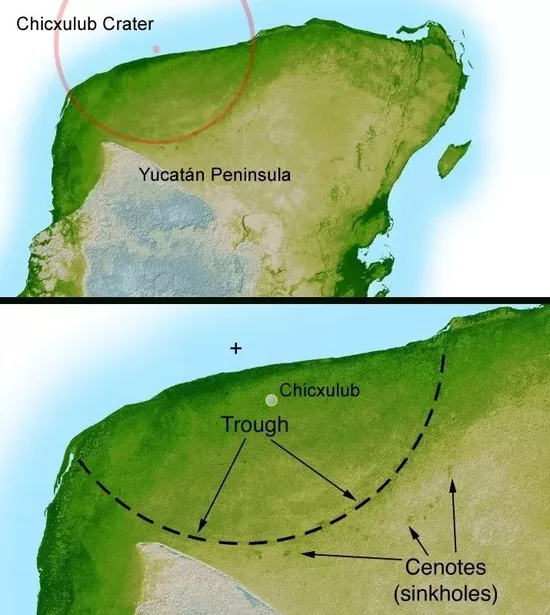
However, 10 million years after the disaster, the world is back to a thriving School: mammals radiate rapidly and develop a variety of types; Reptiles still ruled many places and inherited family businesses from the Mesozoic era; The class radiofin fish began to dominate the ocean, and together with the newly generated reef building organisms, they built the shallow sea ecological environment; Even the surviving birds occupy a wide range of ecological niches. The huge gasornis roams the earth and seems to recall the glory of its ancestors - everything flourished, accompanied by the complete rise of angiosperms - in this new world, large herbivorous mammals have not yet appeared, and although there are few species, dense forests still cover the continent, leaving little space.
Under this prosperous scene, in the ocean, an accident suddenly came.
Today, there are still different opinions on the cause of the accident, but the result is very clear: a gadget called foraminifera ushered in the largest extinction of the Cenozoic.
Foraminifera is an ancient creature with a history almost as old as the whole metazoan group. It's also the most common fossil species we see every day. You can even find them at home - if your home is decorated with carbonate rock, you can find it on it. Of course, if you don't have it at home, you can see it in the surrounding large shopping malls - almost everywhere.
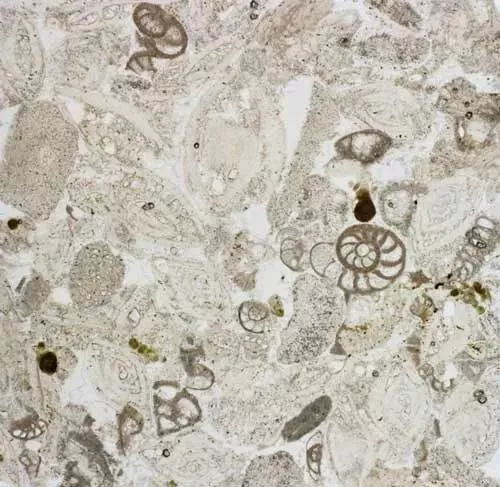
Foraminiferal fossils are common in decoration materials. As long as you carefully observe this kind of white limestone around you, you can basically see it (source: Paul Williams, 'limestone country - limestone, dolomite and marble', teara - the Encyclopedia of New Zealand, http://www.TeAra.govt.nz/en/photograph/12377/limestone )
Of course, not only modern people, but also the pharaohs of ancient Egypt met them almost every day, and even slept with them after death. These fossil animals lying on the stones of the pyramid are called Nummulites, which is the largest protozoa known. It was first recorded by Strabo, a great geologist and historian in ancient Rome - of course, the Nummulites did not become extinct this time. Unfortunately, there is another large group: benthic foraminifera.

The money worms on the pyramids, which were melted by the beans Strabo thought were thrown away by the pyramid builders [2]
In this event, the number of benthic foraminifera decreased sharply, and 30% ~ 50% of all species were extinct. At the same time, it is an amazing carbon emission event: according to estimates, a large amount of carbon dioxide is emitted at an average rate of about 400 million tons per year - and such a rapid and large amount of carbon emission is likely to last for a full 50000 years [3 ]. With the continuous increase of atmospheric carbon dioxide concentration, the earth's average temperature has also increased by 5 ~ 8 ℃. This event is called "Paleocene Eocene thermal maximum", or PETM for short.
PETM was discovered at the beginning because of its sudden insertion and too large size δ The 18O offset value is discarded as an error. Until 1991, Jim Kennett of the University of California, Santa Barbara, again noticed this abnormal isotopic change in the Southern Ocean core: at the junction of Paleocene and Eocene, δ 13C and δ 18O has abnormal drift [4 ]. δ The shift of 18O corresponds to a sharp rise in temperature, while δ The 13C shift represents a surge in carbon dioxide in the atmosphere.

More interestingly, in addition to extinction, foraminiferal groups also showed a more strange response - in 2002, Deborah Thomas noted that the foraminiferal shells in this batch of core samples were only before and after PETM δ 13C value, while the intermediate transition state is missing [5 ]. In other words, foraminifera stopped breeding at the beginning of carbon emissions, or carbon emissions were so fast that they could not be recorded by fossils.
Such rapid carbon emissions are difficult to solve with ordinary volcanic exhaust. Although volcanic activity in Greenland is also in the same period of time, researchers doubt whether it can achieve such a rapid and wide-ranging impact. People began to focus on another important carbon source, methane gas water inclusion complex. This name may not be familiar to everyone, but its other name was a household name ten years ago - combustible ice.
Because the methane in these combustible ice is produced by microbial metabolism, it has more extreme natural characteristics δ Negative drift value of 13C. In the same case, methane can cause more obvious carbon isotope shift than carbon dioxide. But even so, it doesn't explain why δ The negative shift of 13C lasted almost steadily for 45000 years - unless additional carbon was involved.
But where can we make this extra carbon?
Holmes said, "when you eliminate all the impossibilities, the rest, no matter how unreasonable, must be the truth." Although science cannot rely on exclusion to explore the truth, it is indeed an extremely useful way to explore the way - when people can't make up for this additional carbon, it may only come from outside the earth - in 2003, Dennis Kent of Rutgers University boldly judged that a large amount of carbon in PETM came from the impact of a carbon rich asteroid [6 ].
His evidence is the single domain magnetic nanoparticles found in the stratum, which is different from the magnetic particles produced by microorganisms and can only come from outer space. However, his idea has not received widespread attention. After all, an asteroid only hit the earth once 10 million years ago. It seems that it's a little too frequent?
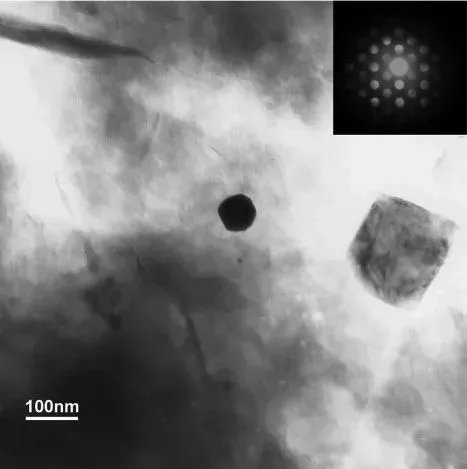
Of course, the more important rebuttal comes mainly from the demand for carbon. If the event was caused by an asteroid, it would need to contribute hundreds of billions of tons of extraterrestrial carbon - which is unthinkable. However, if asteroids are not the main contributor of carbon source, but a trigger process, the model may become very different. Asteroid impact will accelerate the release process of methane hydrate on the earth and induce violent volcanic activity, and the carbon it carries can also rapidly increase the carbon content in the atmosphere in a short time. The result of all this is an obviously abnormal and rapid warming event.
So do we have evidence? The first evidence is indirect, but very interesting. In 2013, James Wright and Morgan Schaller of rensleier University of technology found an extremely strange clay deposit. It is characterized by extremely uniform strip interleaving, so it represents a periodic sedimentary event. According to their judgment, this deposition process is caused by seasonal sunshine. If their judgment is correct, this group of sediments will become the most accurate reference in PETM event [7 ].
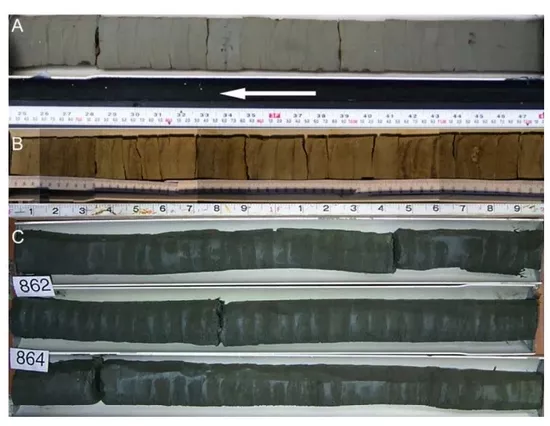
They measured the isotopic changes in the clay and found that δ The rate of decline of 13C is even faster than previously estimated, and it has dropped by four thousandths in just 13 years - this is not a small number. During the rapid warming event at the end of Permian, the drift of stable carbon isotopes was only five thousandths, and its time scale was hundreds of thousands of years. Extremely rapid carbon emissions seem to make asteroid impacts a more credible driver.

In 2016, Morgan Schaller reported another direct evidence, that is, the impact glass located at the PETM boundary found along the Atlantic coast of the United States [8 ]. This is a great evidence of asteroid impact, but until now, we still can't draw a conclusion, because the most important evidence - the impact crater, has no clue.
But craters are not the biggest mystery - the real mystery is extinction. From any geochemical index, PETM is a catastrophic, violent and sudden major change, but it did not induce a mass extinction - on the contrary, it became an important radiation event.
Benthic foraminifera suffered a huge blow, while planktonic foraminifera evolved rapidly and occupied the shallow ocean. Fish are still thriving, and even ushered in a small peak in the tropics. The rapid expansion of insects also ushered in a period of growth in number and species. Mammals have also ushered in a glorious dawn: cloven hoofed, odd hoofed and primates have emerged in this event - it can even be said that humans originated in such high temperatures, accompanied by the largest snake and the smallest horse in history.

The largest snake, the Titan python, may be more than 12m long. It is generally believed that its emergence was inseparable from the high-temperature environment at that time [9]
It seems that everything is safe except the unlucky benthic foraminifera.
This is not an exciting and huge change, but the rapid carbon emission makes us feel familiar - PETM is perhaps the closest climate change event in the history of the earth. But in fact, thanks to the industrial revolution, PETM's asteroids, volcanic activity and methane hydrate can only be dwarfed - we are facing an unprecedented carbon emission process, ten times more than the extreme events caused by PETM's natural additional accidents. At present, the annual carbon dioxide equivalent emitted by humans is about 37000000000 tons per year. At this rate, we will catch up with the total carbon emitted by PETM in 150 years. On this scale, no one can predict what will happen next.
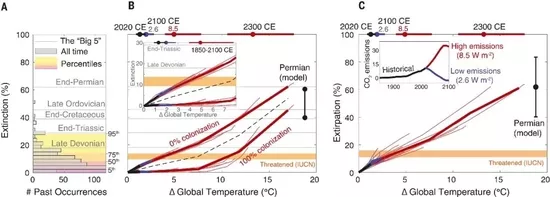
A: The number of Phanerozoic mass extinction events and the extinction rate of marine organisms; B. C: estimated global extinction. When carbon emissions cannot be restrained, we are likely to encounter extinction events equivalent to the losses of past mass extinctions in the short term [10]
"Life will find a way out" - we can't predict what we will see when we explore the strata of our time in tens of millions of years. Even from the industrial revolution, the rapid growth of human carbon emissions is only more than 200 years. On the scale of geological history, what is 200 years? It is not even enough to draw a clear line and provide even a small data point.
However, if we are really in the prelude to extinction, it is no longer important whether we will be recorded. Behind us, there will be thousands of years, tens of thousands of years, hundreds of thousands of years of strata to record what we have done. It will become a slow recovery curve, and the speed of recovery will depend on the intensity of extinction and completely unexpected positive feedback events.
No creature has ever held the pen of writing nature like human beings today, and what to write is in the choice here.
The only regret is that the preface has begun, and we can never lose this pen.